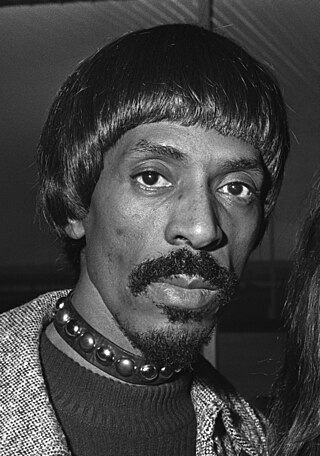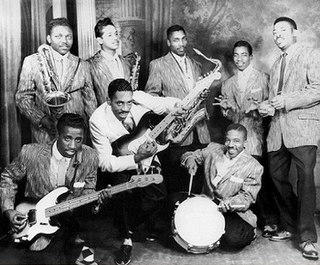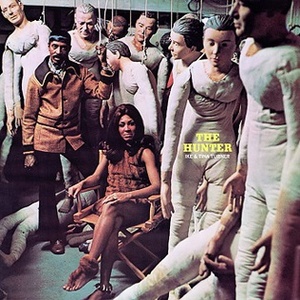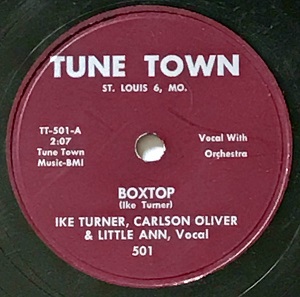
Izear Luster "Ike" Turner Jr. was an American musician, bandleader, songwriter, record producer, and talent scout. An early pioneer of 1950s rock and roll, he is best known for his work in the 1960s and 1970s with his wife Tina Turner as the leader of the Ike & Tina Turner Revue.

Ike & Tina Turner were an American musical duo consisting of husband and wife Ike Turner and Tina Turner. From 1960 to 1976, they performed live as the Ike & Tina Turner Revue, supported by Ike Turner's band, the Kings of Rhythm, and backing vocalists, the Ikettes. The Ike & Tina Turner Revue was regarded as "one of the most potent live acts on the R&B circuit."

Kings of Rhythm are an American music group formed in the late 1940s in Clarksdale, Mississippi and led by Ike Turner through to his death in 2007. Turner would retain the name of the band throughout his career, although the group has undergone considerable line-up changes over time.

Modern Records was an American record company and label formed in 1945 in Los Angeles by the Bihari brothers. Modern's artists included Etta James, Joe Houston, Little Richard, Ike & Tina Turner and John Lee Hooker. The label released some of the most influential blues and R&B records of the 1940s and 1950s.
Kent Records was a Los Angeles–based record label, launched in 1958 by the Bihari brothers. It was subsidiary of Crown Records Corporation. Kent was a follow-up to Modern Records, which ceased operations in 1958. The label reissued Modern's singles, including recordings by B.B. King. By 1964, Kent had signed acts such as Ike & Tina Turner and released new material. Other acts signed to the label included Z.Z. Hill, Johnny Otis, and Lowell Fulsom. Modern Records was revived in 1964 with successful singles from the Ikettes.
RPM Records was an American Los Angeles–based record label launched in 1950. This is not the same RPM used by Tony Bennett, nor is it related to labels in the UK and South Africa.

What's Love Got to Do with It is the first soundtrack by American singer Tina Turner, released on June 15, 1993, by Parlophone. It served as the soundtrack album for the 1993 Tina Turner biographical film of the same name, which was released by Touchstone Pictures that same year. It mostly consists on re-recorded versions of her greatest hits during her period with the Ike and Tina Revue. In celebration of the 30th anniversary of What's Love Got to Do with It, the album was re-released on April 26, 2024 with remixes, single edits and rarities.

Rosco N. Gordon III, sometimes billed as Roscoe Gordon, was an American blues singer, pianist, and songwriter. He is best known for his hit songs "Booted," (1952), "No More Doggin'" (1952), and "Just a Little Bit" (1960). Gordon was a pioneer of the Memphis blues style. He played piano in a style known as the "Rosco rhythm," with the emphasis on the off-beat. This rhythm was an influence on later musical styles such as Jamaican ska and reggae.
The Bihari brothers, Lester, Jules, Saul and Joe, were American businessmen of Hungarian Jewish origins. They were the founders of Modern Records in Los Angeles and its subsidiaries, such as Meteor Records, based in Memphis. The Bihari brothers were significant figures in the process that transformed rhythm and blues into rock and roll, which appealed to white audiences in the 1950s.

"A Fool in Love" is the debut single by Ike & Tina Turner. It was released on Sue Records in 1960. The song is Tina Turner's first release with the stage name "Tina Turner" although she had been singing with Ike Turner and his Kings of Rhythm since 1956. It was the first national hit record for bandleader Ike Turner since the number-one R&B hit "Rocket 88" in 1951, for which he did not receive proper credit.

The Soul of Ike & Tina Turner is the debut album by Ike & Tina Turner. It was released on the Sue Records in February 1961. The album is noted for containing the duo's debut single "A Fool in Love" and their follow-up singles "I Idolize You" and "I'm Jealous."

"Moanin' at Midnight" is a blues song written and recorded by Howlin' Wolf in 1951. The recording was released on Chess Records as his debut single. It charted on Billboard's R&B chart, but the B-side, "How Many More Years," became the popular side of the record.

Rocks The Blues is the first album credited to musician Ike Turner. Released in 1963 from Crown Records, it contains mostly previously released singles from the 1950s.

The Hunter is a studio album by Ike & Tina Turner released on Blue Thumb Records in 1969.

"Boxtop" is a song written and produced by musician Ike Turner. It was originally released as a single in 1958 on Tune Town Records. "Boxtop" is noted for being Tina Turner's first appearance on a record under the name "Little Ann," two years before her debut as Tina Turner on "A Fool In Love" in 1960.

This article contains information about albums and singles released by of American musician and bandleader Ike Turner.
Earl Forest was an American musician and a member of the Memphis-based R&B coalition called the Beale Streeters, which included Johnny Ace, Bobby Bland, Junior Parker, B.B. King, and Roscoe Gordon. Forest had a hit record in 1953 with "Whoopin' And Hollerin'" on Duke Records. He also recorded for Meteor Records and Flair Records.

"No More Doggin'" is a rhythm and blues song written and originally recorded by blues musician Rosco Gordon in 1952. The song featured Gordon's signature "Rosco Rhythm" piano style which became a precursor to Jamaican ska music.
The Beale Streeters were a Memphis-based R&B coalition of musicians, which at times included John Alexander, Bobby Bland, Junior Parker, B.B. King, Earl Forest, Willie Nix, and Rosco Gordon. Initially, they were not a formal band, but they played at the same venues and backed each other during recording sessions.














